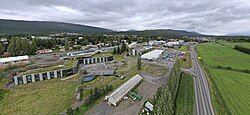|
Egilsstaðir
Egilsstaðir (Icelandic pronunciation: [ˈeijɪlsˌstaːðɪr̥]) is a town in east Iceland on the banks of the Lagarfljót river. It is part of the municipality of Múlaþing and the largest settlement of the Eastern Region with, as of 2024, a population of 2,632 inhabitants. Formerly Egilsstaðir was part of Norður-Múlasýsla. OverviewEgilsstadir is located at 65°17′N 14°23′W / 65.283°N 14.383°W. The town is young, even by Icelandic standards where urbanization is a fairly recent trend compared to mainland Europe. It was established in 1947 as an effort by the surrounding rural districts recognizing it had become a regional service centre. The town takes name from an individual farmstead and is in this respect relatively unique within the country where most or all of the towns take name from broader landmarks. It is near the bridge over Lagarfljót where all the main roads of the region meet, Route 1 as well as the main routes to the Eastern Region. Egilsstaðir has grown to become the largest town of East Iceland and its main service, transportation, and administration centre. The town has an airport, college, and a hospital. The town grew quickly during the economic boom in the region from 2004 to 2008 associated with the building of the Kárahnjúkar Hydropower Plant and Alcoa's aluminium smelting plant in Reyðarfjörður. The growth has slowed markedly since the banking collapse in 2008. HistoryIn written accounts, Egilsstaðir is first mentioned in the 15th century as a place for legislative assembly. Nothing is therefore known with certainty about the individual person Egil lending it its name, the only conjecture to this effect met with in books detailing the story of the town is that it may be named after Egil Síðu-Hallsson, but Hallr at Síða was a captain in the east and an uncle to Rollo in France, but this guess is of controlled probability and most likely the person left no other recort of himself. The nearby river Eyvindará is mentioned in the Saga of the Sons of Droplaug and Saga of the inhabitants of Fljótsdalur. Urbanization in Egilsstaðir can be traced to Jón Bergsson (1855–1923), a farmer, who laid the groundwork for increased commerce and services at the Egilsstaðir farm by erecting a large residential building there at the start of the 20th century. The house is still in use as a hotel. Jón bought the farm Egilsstaðr at the close of the 19th century because of its location when he predicted "Crossroads will be here", which proved prescient.[1] Along with others, Jón Bergsson also took the initiative to establish the co-operative Kaupfélag Héraðsbúa (KHB) with headquarters there in 1909.[2] [3] In subsequent years, bridges were built over Lagarfljót river and Eyvindará river and a road made over Fagridalur to Reyðarfjörður. Later, the regional headquarters for mail and telephone services were located at Egilsstaðir.[4]  In 1947 Egilsstaðir was incorporated as a town and a rural jurisdiction Egilsstaðahreppur, with neighbouring jurisdictions Vallahreppur and Eiðahreppur joining the new jurisdiction. The town soon grew and by 1980 the population exceeded 1000. In 1987, the status of the town was upgraded to kaupstaður and renamed Egilsstaðabær, or the town of Egilsstaðir. In early 2011, the population was 2,257 and had increased by 41 percent from 2001, when 1,600 were registered there.[5] On 7 June 1998 Egilsstaðabær was united with Vallahreppur, Skriðdalshreppur, Eiðahreppur and Hjaltastaðarhreppur under the name Austur-Hérað. Austur-Hérað then became Fljótsdalshérað in 2004. In 2020 it joined other municipalities to form Múlaþing. ClimateDepending on isotherm Egilsstaðir has a subarctic climate (Köppen: Dfc) or a subpolar oceanic climate (Cfc) bordering very closely on a Tundra climate (ET). Winters there tend to be colder than other towns in the area, and summers tend to have daytime highs often exceeding 15 °C (59 °F), higher than most of Iceland, but at night it is colder than most towns with a similar climate. The town being at a relatively low elevation somewhat shielded from maritime winds enables warmer air to stay for longer than in coastal areas, although the effect of southerlies become negated by high mountains blocking such winds, and as a result Egilsstaðir still has a lot cooler summers than continental Nordic climates have on similar latitudes. Egilsstaðir being relatively close to the east coast also increased the maritime moderation both in summer and winter. With Central Iceland being at a highland tundra, the Egilsstaðir area is still the warmest for 1961–1990 summer maxima among Icelandic weather stations for populated areas. The figures here given for precipitation days and sunshine hours belong to Grímsárvirkjun and Hallormsstaður, which are 15 kilometres (9 mi) and 25 kilometres (16 mi) away from Egilsstaðir respectively and get around 100 millimetres (4 in) more precipitation than Egilsstaðir, so it is possible that Egilsstaðir has fewer days with precipitation and gets more sunlight than stated below. The highest temperature recorded is 29.2 °C (84.6 °F) on 11 August 2004, recorded at Egilsstaðir Airport.[6]
The climate has significantly warmed in recent years, as seen in the climate averages for the 1991–2020 reference period.
Points of interest
Notable natives
References
External links
|
||||||||||||||||||||||||||||||||||||||||||||||||||||||||||||||||||||||||||||||||||||||||||||||||||||||||||||||||||||||||||||||||||||||||||||||||||||||||||||||||||||||||||||||||||||||||||||||||||||||||||||||||||||||||||||||||||||||||||||||||||||||||||||||||||||||||||||||||
Portal di Ensiklopedia Dunia



